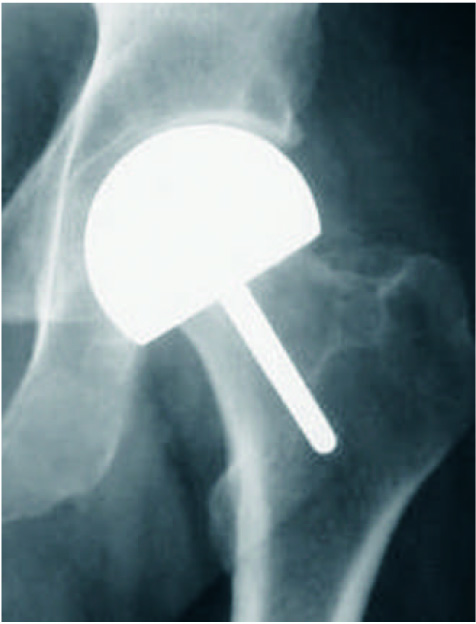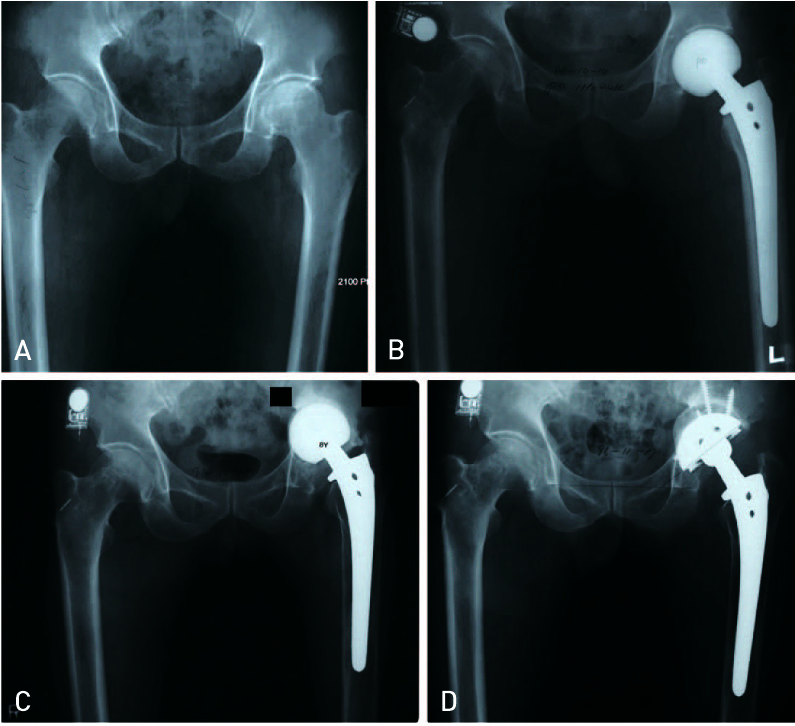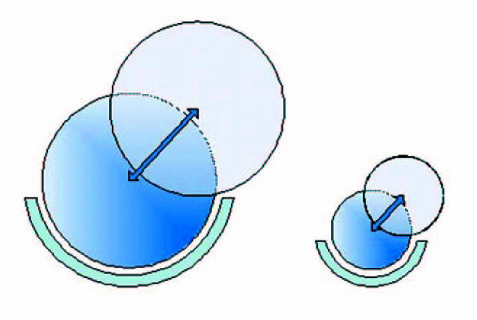Hip Pelvis.
2014 Jun;26(2):65-73. 10.5371/hp.2014.26.2.65.
Arthroplasty in Femoral Head Osteonecrosis
- Affiliations
-
- 1Department of Orthopedic Surgery, Kyung Hee University School of Medicine, Seoul, Korea. yjcho@khmc.or.kr
- KMID: 2054166
- DOI: http://doi.org/10.5371/hp.2014.26.2.65
Abstract
- Osteonecrosis of the femoral head is a destructive joint disease requiring early hip arthroplasty. The polyethylene-metal design using a 22-mm femoral head component, introduced by Charnley in 1950, has been widely used for over half a century. Since then, different materials with the capacity to minimize friction between bearing surfaces and various cement or cementless insert fixations have been developed. Although the outcome of second and third generation designs using better bearing materials and technologies has been favorable, less favorable results are seen with total hip arthroplasty in young patients with osteonecrosis. Selection of appropriate materials for hip arthroplasty is important for any potential revisions that might become inevitable due to the limited durability of a prosthetic hip joint. Alternative hip arthroplasties, which include hemiresurfacing arthroplasty and bipolar hemiarthroplasty, have not been found to have acceptable outcomes. Metal-on-metal resurfacing has recently been suggested as a feasible option for young patients with extra physical demands; however, concerns about complications such as hypersensitivity reaction or pseudotumor formation on metal bearings have emerged. To ensure successful long-term outcomes in hip arthroplasty, factors such as insert stabilization and surfaces with less friction are essential. Understanding these aspects in arthroplasty is important to selection of proper materials and to making appropriate decisions for patients with osteonecrosis of the femoral head.
MeSH Terms
Figure
Reference
-
1. Beaulé PE, Amstutz HC. Management of Ficat stage III and IV osteonecrosis of the hip. J Am Acad Orthop Surg. 2004; 12:96–105.
Article2. Lieberman JR, Berry DJ, Mont MA, et al. Osteonecrosis of the hip: management in the 21st century. Instr Course Lect. 2003; 52:337–355.3. Assouline-Dayan Y, Chang C, Greenspan A, Shoenfeld Y, Gershwin ME. Pathogenesis and natural history of osteonecrosis. Semin Arthritis Rheum. 2002; 32:94–124.
Article4. Mont MA, Hungerford DS. Non-traumatic avascular necrosis of the femoral head. J Bone Joint Surg Am. 1995; 77:459–474.
Article5. Brinker MR, Rosenberg AG, Kull L, Galante JO. Primary total hip arthroplasty using noncemented porous-coated femoral components in patients with osteonecrosis of the femoral head. J Arthroplasty. 1994; 9:457–468.
Article6. Cabanela ME. Bipolar versus total hip arthroplasty for avascular necrosis of the femoral head. A comparison. Clin Orthop Relat Res. 1990; 261:59–62.
Article7. Saito S, Saito M, Nishina T, Ohzono K, Ono K. Long-term results of total hip arthroplasty for osteonecrosis of the femoral head. A comparison with osteoarthritis. Clin Orthop Relat Res. 1989; 244:198–207.8. Ito H, Matsuno T, Kaneda K. Bipolar hemiarthroplasty for osteonecrosis of the femoral head. A 7- to 18-year followup. Clin Orthop Relat Res. 2000; 374:201–211.9. Tsumura H, Torisu T, Kaku N, Higashi T. Five- to fifteen-year clinical results and the radiographic evaluation of acetabular changes after bipolar hip arthroplasty for femoral head osteonecrosis. J Arthroplasty. 2005; 20:892–897.
Article10. Mont MA, Rajadhyaksha AD, Hungerford DS. Outcomes of limited femoral resurfacing arthroplasty compared with total hip arthroplasty for osteonecrosis of the femoral head. J Arthroplasty. 2001; 16:8 Suppl 1. 134–139.
Article11. Beaulé PE, Schmalzried TP, Campbell P, Dorey F, Amstutz HC. Duration of symptoms and outcome of hemiresurfacing for hip osteonecrosis. Clin Orthop Relat Res. 2001; 385:104–117.
Article12. Cuckler JM, Moore KD, Estrada L. Outcome of hemiresurfacing in osteonecrosis of the femoral head. Clin Orthop Relat Res. 2004; 429:146–150.
Article13. Gabriel JL, Trousdale RT. Stem fracture after hemiresurfacing for femoral head osteonecrosis. J Arthroplasty. 2003; 01. 18:96–99.
Article14. Tooke SM, Amstutz HC, Delaunay C. Hemiresurfacing for femoral head osteonecrosis. J Arthroplasty. 1987; 2:125–133.
Article15. Grevitt MP, Spencer JD. Avascular necrosis of the hip treated by hemiarthroplasty. Results in renal transplant recipients. J Arthroplasty. 1995; 10:205–211.16. Chan YS, Shih CH. Bipolar versus total hip arthroplasty for hip osteonecrosis in the same patient. Clin Orthop Relat Res. 2000; 379:169–177.
Article17. Lachiewicz PF, Desman SM. The bipolar endoprosthesis in avascular necrosis of the femoral head. J Arthroplasty. 1988; 3:131–138.
Article18. Acurio MT, Friedman RJ. Hip arthroplasty in patients with sickle-cell haemoglobinopathy. J Bone Joint Surg Br. 1992; 74:367–371.
Article19. Lieberman JR, Fuchs MD, Haas SB, et al. Hip arthroplasty in patients with chronic renal failure. J Arthroplasty. 1995; 10:191–195.
Article20. Park KS, Tumin M, Peni I, Yoon TR. Conversion total hip arthroplasty after previous transtrochanteric rotational osteotomy for osteonecrosis of the femoral head. J Arthroplasty. 2014; 29:813–816.
Article21. Lee YK, Ha YC, Kim KC, Yoo JJ, Koo KH. Total hip arthroplasty after previous transtrochanteric anterior rotational osteotomy for femoral head osteonecrosis. J Arthroplasty. 2009; 24:1205–1209.
Article22. Kantor SG, Huo MH, Huk OL, Salvati EA. Cemented total hip arthroplasty in patients with osteonecrosis. A 6-year minimum follow-up study of second-generation cement techniques. J Arthroplasty. 1996; 11:267–271.23. Garino JP, Steinberg ME. Total hip arthroplasty in patients with avascular necrosis of the femoral head: a 2- to 10-year follow-up. Clin Orthop Relat Res. 1997; 334:108–115.
Article24. Phillips FM, Pottenger LA, Finn HA, Vandermolen J. Cementless total hip arthroplasty in patients with steroid-induced avascular necrosis of the hip. A 62-month follow-up study. Clin Orthop Relat Res. 1994; 303:147–154.25. Wroblewski BM, Siney PD, Fleming PA. The Charnley hip replacement--43 years of clinical success. Acta Chir Orthop Traumatol Cech. 2006; 73:6–9.26. Digas G, Kärrholm J, Thanner J, Malchau H, Herberts P. The Otto Aufranc Award. Highly cross-linked polyethylene in total hip arthroplasty: randomized evaluation of penetration rate in cemented and uncemented sockets using radiostereometric analysis. Clin Orthop Relat Res. 2004; 429:6–16.
Article27. Cornell CN, Salvati EA, Pellicci PM. Long-term follow-up of total hip replacement in patients with osteonecrosis. Orthop Clin North Am. 1985; 16:757–769.
Article28. Kurtz SM, Muratoglu OK, Evans M, Edidin AA. Advances in the processing, sterilization, and crosslinking of ultra-high molecular weight polyethylene for total joint arthroplasty. Biomaterials. 1999; 20:1659–1688.
Article29. Sakoda H, Voice AM, McEwen HM, et al. A comparison of the wear and physical properties of silane cross-linked polyethylene and ultra-high molecular weight polyethylene. J Arthroplasty. 2001; 16:1018–1023.
Article30. Nich C, Sariali el-H, Hannouche D, et al. Long-term results of alumina-on-alumina hip arthroplasty for osteonecrosis. Clin Orthop Relat Res. 2003; 417:102–111.31. Fye MA, Huo MH, Zatorski LE, Keggi KJ. Total hip arthroplasty performed without cement in patients with femoral head osteonecrosis who are less than 50 years old. J Arthroplasty. 1998; 13:876–881.
Article32. Park YS, Hwang SK, Choy WS, Kim YS, Moon YW, Lim SJ. Ceramic failure after total hip arthroplasty with an alumina-on-alumina bearing. J Bone Joint Surg Am. 2006; 88:780–787.
Article33. Koo KH, Ha YC, Jung WH, Kim SR, Yoo JJ, Kim HJ. Isolated fracture of the ceramic head after third-generation alumina-on-alumina total hip arthroplasty. J Bone Joint Surg Am. 2008; 90:329–336.
Article34. Restrepo C, Post ZD, Kai B, Hozack WJ. The effect of stem design on the prevalence of squeaking following ceramic-on-ceramic bearing total hip arthroplasty. J Bone Joint Surg Am. 2010; 92:550–557.
Article35. Walter WL, Kurtz SM, Esposito C, et al. Retrieval analysis of squeaking alumina ceramic-on-ceramic bearings. J Bone Joint Surg Br. 2011; 93:1597–1601.
Article36. Smith-Petersen MN. Approach to and exposure of the hip joint for mold arthroplasty. J Bone Joint Surg Am. 1949; 31A:40–46.
Article37. Smith-Petersen MN, Aufranc OE, Larson CB. Principle of mold arthroplasty as applied to the hip. Surg Clin North Am. 1947; 27:1303–1306.
Article38. McMinn D, Treacy R, Lin K, Pynsent P. Metal on metal surface replacement of the hip. Experience of the McMinn prothesis. Clin Orthop Relat Res. 1996; 329 Suppl. S89–S98.39. Daniel J, Pynsent PB, McMinn DJ. Metal-on-metal resurfacing of the hip in patients under the age of 55 years with osteoarthritis. J Bone Joint Surg Br. 2004; 86:177–184.
Article40. Clarke MT, Lee PT, Villar RN. Dislocation after total hip replacement in relation to metal-on-metal bearing surfaces. J Bone Joint Surg Br. 2003; 85:650–654.
Article41. Shimmin AJ, Bare J, Back DL. Complications associated with hip resurfacing arthroplasty. Orthop Clin North Am. 2005; 36:187–193.
Article42. Higuchi F, Inoue A, Semlitsch M. Metal-on-metal CoCrMo McKee-Farrar total hip arthroplasty: characteristics from a long-term follow-up study. Arch Orthop Trauma Surg. 1997; 116:121–124.
Article43. Jantsch S, Schwägerl W, Zenz P, Semlitsch M, Fertschak W. Long-term results after implantation of McKee-Farrar total hip prostheses. Arch Orthop Trauma Surg. 1991; 110:230–237.
Article44. Schmalzried TP, Fowble VA, Ure KJ, Amstutz HC. Metal on metal surface replacement of the hip. Technique, fixation, and early results. Clin Orthop Relat Res. 1996; 329 Suppl. S106–S114.45. Amstutz HC, Graff-Radford A, Mai LL, Thomas BJ. Surface replacement of the hip with the Tharies system. Two to five-year results. J Bone Joint Surg Am. 1981; 63:1069–1077.
Article46. Wagner H. Surface replacement arthroplasty of the hip. Clin Orthop Relat Res. 1978; 134:102–130.
Article47. Beaulé PE, Amstutz HC, Le Duff M, Dorey F. Surface arthroplasty for osteonecrosis of the hip: hemiresurfacing versus metal-on-metal hybrid resurfacing. J Arthroplasty. 2004; 19:8 Suppl 3. 54–58.48. Mont MA, Seyler TM, Marker DR, Marulanda GA, Delanois RE. Use of metal-on-metal total hip resurfacing for the treatment of osteonecrosis of the femoral head. J Bone Joint Surg Am. 2006; 88:Suppl 3. 90–97.
Article49. Beaulé PE, Le Duff M, Amstutz HC. Hemiresurfacing arthroplasty of the hip for failed free-vascularized fibular graft. J Arthroplasty. 2003; 18:519–523.
Article50. de Steiger RN, Miller LN, Prosser GH, Graves SE, Davidson DC, Stanford TE. Poor outcome of revised resurfacing hip arthroplasty. Acta Orthop. 2010; 81:72–76.
Article51. de Steiger RN, Hang JR, Miller LN, Graves SE, Davidson DC. Five-year results of the ASR XL Acetabular System and the ASR Hip Resurfacing System: an analysis from the Australian Orthopaedic Association National Joint Replacement Registry. J Bone Joint Surg Am. 2011; 93:2287–2293.
Article52. Hug KT, Watters TS, Vail TP, Bolognesi MP. The withdrawn ASR™ THA and hip resurfacing systems: how have our patients fared over 1 to 6 years? Clin Orthop Relat Res. 2013; 471:430–438.
Article53. Delaunay C, Petit I, Learmonth ID, Oger P, Vendittoli PA. Metal-on-metal bearings total hip arthroplasty: the cobalt and chromium ions release concern. Orthop Traumatol Surg Res. 2010; 96:894–904.
Article54. Grosclaude S, Adam P, Besse JL, Fessy MH. Iliopsoas bursal distension revealing complication of total hip arthroplasty: five cases. Rev Chir Orthop Reparatrice Appar Mot. 2006; 92:351–357.55. Hananouchi T, Saito M, Nakamura N, Yamamoto T, Yonenobu K. Huge pelvic mass secondary to wear debris causing ureteral obstruction. J Arthroplasty. 2005; 20:946–949.
Article
- Full Text Links
- Actions
-
Cited
- CITED
-
- Close
- Share
- Similar articles
-
- Total Hip Arthroplasty in Patient with Osteonecrosis of the Femoral Head Following Liver Transplantation: Case Report
- An Enlarged Iliopsoas Bursa Associated with Osteonecrosis of the Femoral Head: A Case Report
- Total Hip Arthroplasty in Patients with Avascular Necrosis of the Entire Femur
- Total Hip Replacement Arthroplasty in Patient with Idiopathic Thrombocytopenic Purpura: Clinical Experience of Perioperative Management
- Total Hip Arthroplasty for Osteonecrosis of the Femoral Head Following Cardiac Transplantation: A Case Report







